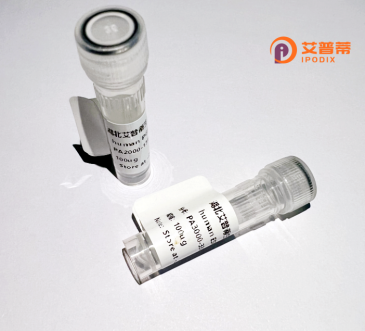
| 纯度 | >90%SDS-PAGE. |
| 种属 | Human |
| 靶点 | IDP |
| Uniprot No | P48735 |
| 内毒素 | < 0.01EU/μg |
| 表达宿主 | E.coli |
| 表达区间 | 40-452aa |
| 氨基酸序列 | A DKRIKVAKPV VEMDGDEMTR IIWQFIKEKL ILPHVDIQLK YFDLGLPNRD QTDDQVTIDS ALATQKYSVA VKCATITPDE ARVEEFKLKK MWKSPNGTIR NILGGTVFRE PIICKNIPRL VPGWTKPITI GRHAHGDQYK ATDFVADRAG TFKMVFTPKD GSGVKEWEVY NFPAGGVGMG MYNTDESISG FAHSCFQYAI QKKWPLYMST KNTILKAYDG RFKDIFQEIF DKHYKTDFDK NKIWYEHRLI DDMVAQVLKS SGGFVWACKN YDGDVQSDIL AQGFGSLGLM TSVLVCPDGK TIEAEAAHGT VTRHYREHQK GRPTSTNPIA SIFAWTRGLE HRGKLDGNQD LIRFAQMLEK VCVETVESGA MTKDLAGCIH GLSNVKLNEH FLNTTDFLDT IKSNLDRALG RQ |
| 预测分子量 | 50,9 kDa |
| 蛋白标签 | His tag N-Terminus |
| 缓冲液 | PBS, pH7.4, containing 0.01% SKL, 1mM DTT, 5% Trehalose and Proclin300. |
| 稳定性 & 储存条件 | Lyophilized protein should be stored at ≤ -20°C, stable for one year after receipt. Reconstituted protein solution can be stored at 2-8°C for 2-7 days. Aliquots of reconstituted samples are stable at ≤ -20°C for 3 months. |
| 复溶 | Always centrifuge tubes before opening.Do not mix by vortex or pipetting. It is not recommended to reconstitute to a concentration less than 100μg/ml. Dissolve the lyophilized protein in distilled water. Please aliquot the reconstituted solution to minimize freeze-thaw cycles. |
以下是关于IDP(内在无序蛋白)重组蛋白的3-4篇参考文献,涵盖表达策略、结构分析和功能研究:
---
1. **文献名称**:*Intrinsically disordered proteins: regulation and disease*
**作者**:Uversky, V.N., Oldfield, C.J., Dunker, A.K.
**摘要**:综述了内在无序蛋白(IDPs)在细胞调控和疾病(如癌症、神经退行性疾病)中的作用,讨论了其重组表达的难点(如溶解度低、易聚集)及可能的解决方案(如融合标签、缓冲液优化)。
2. **文献名称**:*Recombinant expression and purification of intrinsically disordered proteins: Strategies and challenges*
**作者**:Xue, B., Blocquel, D., Habchi, J. et al.
**摘要**:系统总结了IDPs重组表达的优化策略,包括宿主选择(大肠杆菌、昆虫细胞)、融合蛋白设计(如SUMO、MBP标签)及纯化方法,强调动态结构对功能研究的影响。
3. **文献名称**:*NMR analysis of the conformational ensemble of an intrinsically disordered protein*
**作者**:Jensen, M.R., Zweckstetter, M., Huang, J. et al.
**摘要**:利用核磁共振(NMR)技术研究重组表达的IDP(如α-synuclein)的构象动态,揭示其结构无序性与结合配体的功能关联。
4. **文献名称**:*Small-angle X-ray scattering studies of intrinsically disordered proteins*
**作者**:Bernadó, P., Svergun, D.I.
**摘要**:通过小角X射线散射(SAXS)分析重组IDPs的溶液结构,证明其多构象态特性,并探讨该方法在解析动态结构中的应用价值。
---
这些文献涵盖了IDP重组表达的技术挑战、结构分析方法及其在疾病研究中的意义,适合作为相关研究的理论或方法学参考。
**Background of IDP Recombinant Proteins**
Intrinsically disordered proteins (IDPs) are a class of proteins lacking a fixed three-dimensional structure under physiological conditions, yet they play critical roles in cellular processes such as signaling, regulation, and molecular recognition. Unlike traditional structured proteins, IDPs exhibit conformational flexibility, enabling them to interact with diverse binding partners. This adaptability makes them essential in processes like transcription, cell cycle control, and stress responses. However, their inherent flexibility also poses challenges in studying and utilizing them experimentally.
Recombinant protein technology, which involves producing proteins by expressing cloned genes in host systems (e.g., *E. coli*, yeast, or mammalian cells), has become a cornerstone for studying IDPs. IDP recombinant proteins are engineered to retain their functional disorder while enabling large-scale production for research or therapeutic applications. Key advancements, such as fusion tags (e.g., GST, His-tag) and solubility enhancers, have improved their stability and purification. Additionally, optimized expression conditions (e.g., low temperature, chaperone co-expression) help mitigate aggregation, a common issue due to IDPs’ exposed hydrophobic regions.
The applications of recombinant IDPs span drug discovery, structural biology, and biomaterials. For example, disordered regions in proteins like tau (linked to neurodegenerative diseases) or p53 (a tumor suppressor) are targets for therapeutic intervention. Recombinant IDPs also serve as tools to study protein-protein interaction networks or phase separation phenomena.
Despite progress, challenges remain, including maintaining native-like disorder post-purification and scaling production for clinical use. Innovations in synthetic biology, machine learning-guided design, and alternative expression systems (e.g., cell-free or *Pichia pastoris*) are addressing these limitations. Overall, IDP recombinant proteins bridge the gap between understanding dynamic protein behavior and leveraging their unique properties for biomedical and industrial purposes.
×